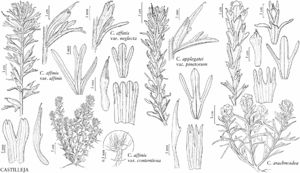Difference between revisions of "Castilleja arachnoidea"
Bot. Gaz. 53: 510. 1912.
FNA>Volume Importer |
FNA>Volume Importer |
||
| Line 71: | Line 71: | ||
|publication year=1912 | |publication year=1912 | ||
|special status=Selected by author to be illustrated;Endemic | |special status=Selected by author to be illustrated;Endemic | ||
| − | |source xml=https://jpend@bitbucket.org/aafc-mbb/fna-data-curation.git/src/ | + | |source xml=https://jpend@bitbucket.org/aafc-mbb/fna-data-curation.git/src/f6b125a955440c0872999024f038d74684f65921/coarse_grained_fna_xml/V17/V17_1032.xml |
|genus=Castilleja | |genus=Castilleja | ||
|species=Castilleja arachnoidea | |species=Castilleja arachnoidea | ||
Revision as of 18:26, 24 September 2019
Herbs, perennial, 0.6–2(–3) dm; from branched, sometimes elongate, creeping basal stems; with a taproot. Stems solitary or few to many, decumbent-ascending, unbranched, sometimes branched, hairs dense, reflexed-spreading, matted, long, soft, unbranched, eglandular, white-woolly. Leaves green to purple or steel gray, lanceolate-linear or narrowly lanceolate, (1–)2–4(–6) cm, not fleshy, margins plane, involute, 3(–5)-lobed, apex acute; lobes spreading, linear to lanceolate, apex acute to rounded. Inflorescences erect to ascending, 3–12 × 1–2.5 cm; bracts proximally greenish to dull reddish brown, rarely dull red or dull orange, distally dull red, deep rusty red, or yellow to pale yellow, sometimes deep pink, dull rose, pale salmon, or dull light orange, rarely green, dull reddish, or dull orange throughout, aging browner and/or more orange, lanceolate or elliptic-lanceolate to obovate, (0–)3–5-lobed; lobes usually ascending, linear, lanceolate, oblanceolate, or spatulate, long, arising near or below mid length, central lobe apex rounded to truncate, others obtuse to rounded. Calyces colored as bracts, proximal part sometimes paler, (10–)12–19 mm; abaxial and adaxial clefts 4–8(–10) mm, 33–50% of calyx length, all 4 clefts subequal; lobes linear to lanceolate, apex acute. Corollas straight or ± curved, 12–20 mm; tube 9–15 mm; beak subequal to calyx or slightly exserted, adaxially green or yellow-green, (2–)3–5 mm, ± densely puberulent, hairs often crisped; abaxial lip yellow, greenish, pink, or red-violet, moderately conspicuous, exserted to barely included in calyx; pouches shallow, prominent, 2–4 mm, ca. 100% as long as beak; teeth erect, red, pink, or pale yellow, 1 mm. 2n = 24.
Phenology: Flowering (May–)Jun–Aug(–Sep).
Habitat: Pumice flats, sandy, gravelly, or rocky slopes, ridges and open summits.
Elevation: 1300–3300 m.
Distribution
Calif., Nev., Oreg.
Discussion
Castilleja arachnoidea is a remarkably variable species in form and color, but inflorescence colors are often uniform within a population. It is sometimes confused with C. schizotricha, but the two differ in stature, lobing of the leaves and bracts, bract coloration, and inflation of the abaxial lip. They are easily separated by the simple hairs and pale yellow to brick red inflorescences of C. arachnoidea, compared to the pink-purple to deep purple inflorescences and branched hairs of C. schizotricha.
The names Castilleja eastwoodiana and C. filifolia represent yellow color forms of C. arachnoidea. A race on the pumice plains of Mt. Shasta in the Cascade Range in California is distinctive.
Selected References
None.
